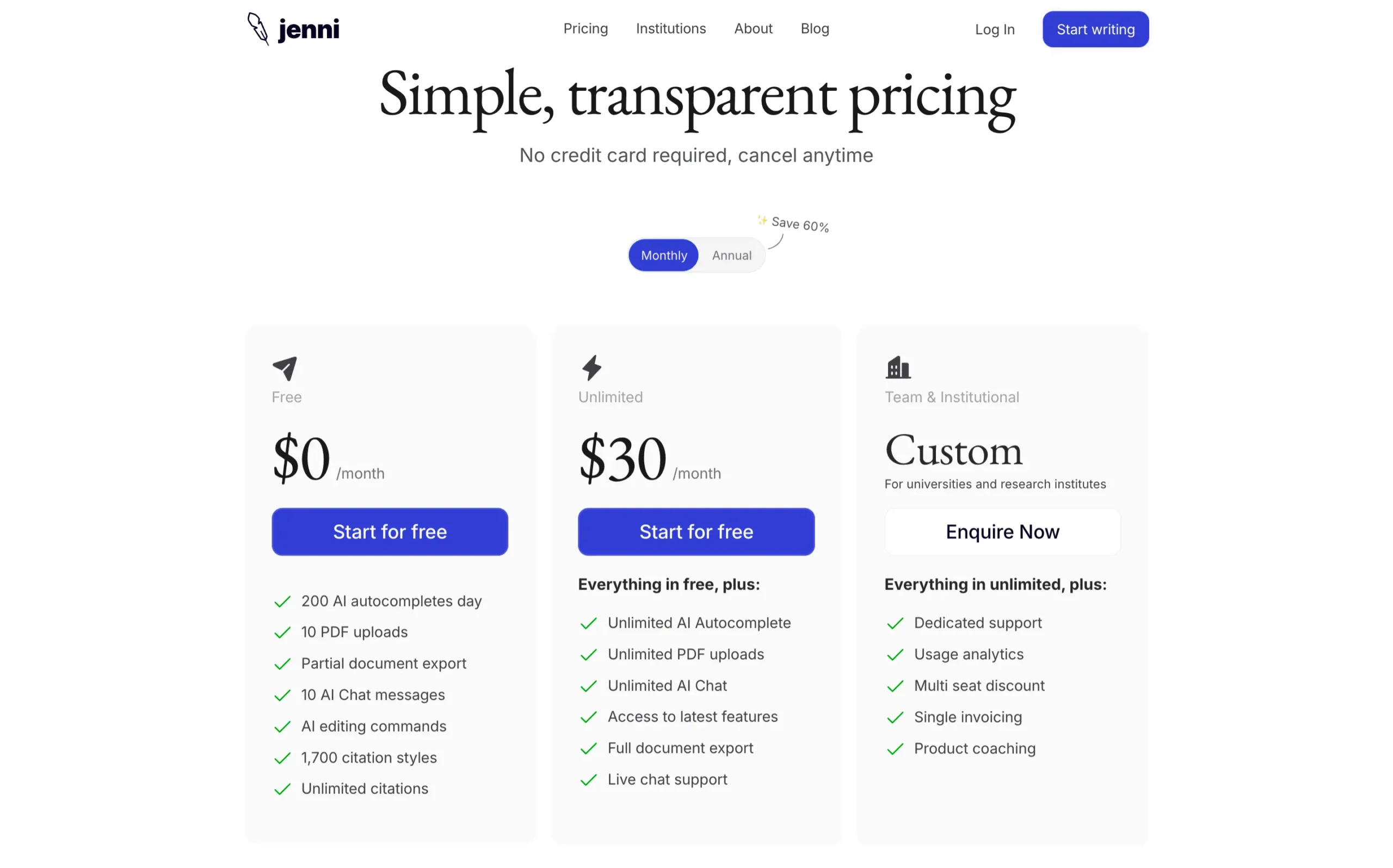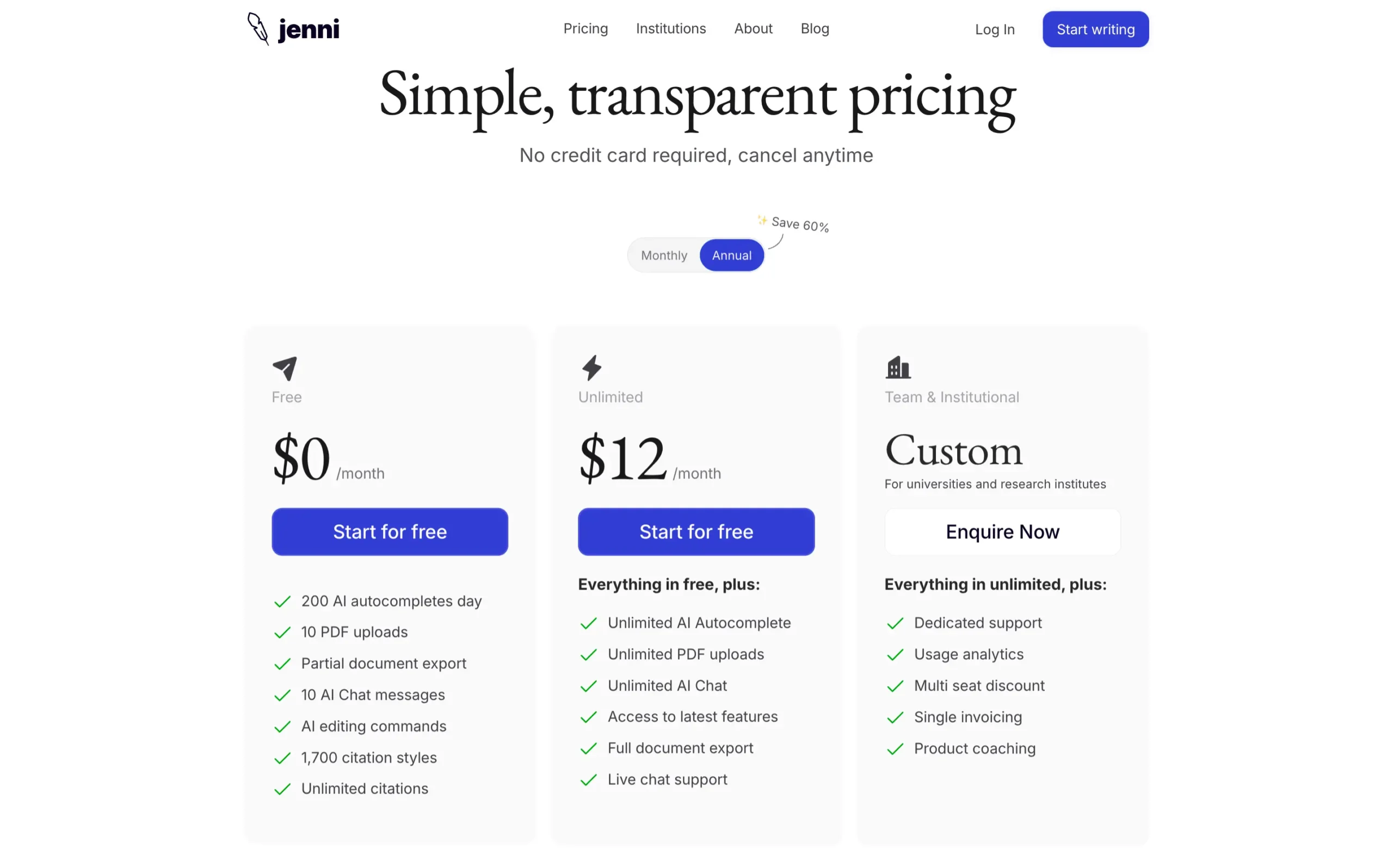Jenni AI vs Paperpal: I Tested Both. Here’s the Winner

Jenni AI and Paperpal look similar on the surface. Both help with academic writing, both have millions of users, and both cost around $12-30/month.
But they solve completely different problems.
Jenni AI does one thing brilliantly: it keeps you writing when you’re stuck. Clean interface, smart autocomplete, zero bloat. It’s for people who want writing help without distractions.
Paperpal tries to replace your entire academic toolkit. Grammar checking trained on 250+ million research papers. Plagiarism detection across 99 billion web pages. Research features that pull from academic databases. It’s for people who need everything connected.
I used both tools with real academic writing. I uploaded the same PDFs, tested the same features, and compared the same outputs.
This isn’t a “both tools are great” review. Within the next few minutes, you’ll know exactly which tool fits your workflow—and which one wastes your money.
Here’s what I found, feature by feature.
TL;DR Summary

Jenni AI does one thing really well: it helps you write when you’re stuck. Clean interface, smart autocomplete, zero distractions. Think of it as a writing buddy that suggests your next sentence. $12/month yearly, web-only.

Paperpal tries to replace your entire academic toolkit. Grammar checking trained on 250 million research papers. Free plagiarism detection. Research features. Works in Word, Google Docs, and Overleaf. $11.60/month yearly.
The verdict? Paperpal wins for most people. You get more features for less money. You’ll need grammar checking and plagiarism detection eventually anyway—buying separate tools costs more than Paperpal’s single subscription.
Jenni AI overview
Available on: web.

What I like about Jenni AI
What I don’t like about Jenni AI
Jenni AI is an AI assistant that helps you write academic papers faster without doing the work for you.
Over 5 million academics already use it, which tells you something. When that many researchers trust a tool with their papers, it’s probably solving real problems.
What makes Jenni different from ChatGPT?
It’s built specifically for academic writing. You can cite sources in over 1,700 citation styles, including the ones you actually need—APA, MLA, IEEE, Harvard, and Chicago.
Further reading: Looking for more citation help? Check out my guide to the 5 best AI citation generators.
It supports over 30 languages, so whether you’re writing in English, Spanish, German, French, or Chinese, it adapts.
Jenni AI does three things well: it helps you write with AI autocomplete when you’re stuck, manages your citations automatically, and lets you chat with your PDFs to pull out key information.
You can import your existing research from Zotero and Mendeley, which means you don’t have to start over.
One thing missing?
Real-time collaboration. It’s coming soon, according to their team page.
Here’s what you need to know upfront: Jenni AI is laser-focused on helping you write. It’s not trying to be everything to everyone.
You won’t find advanced grammar checking trained on academic texts, plagiarism detection, journal submission checks, or literature review discovery.
Those features live in more comprehensive tools like Paperpal.
This focused approach has trade-offs. Jenni does writing assistance really well, but if you need a full academic research assistant, you’ll need to look elsewhere.
Paperpal overview
Available on: web, MS Word, Google Docs, and Overleaf (Chrome extension).
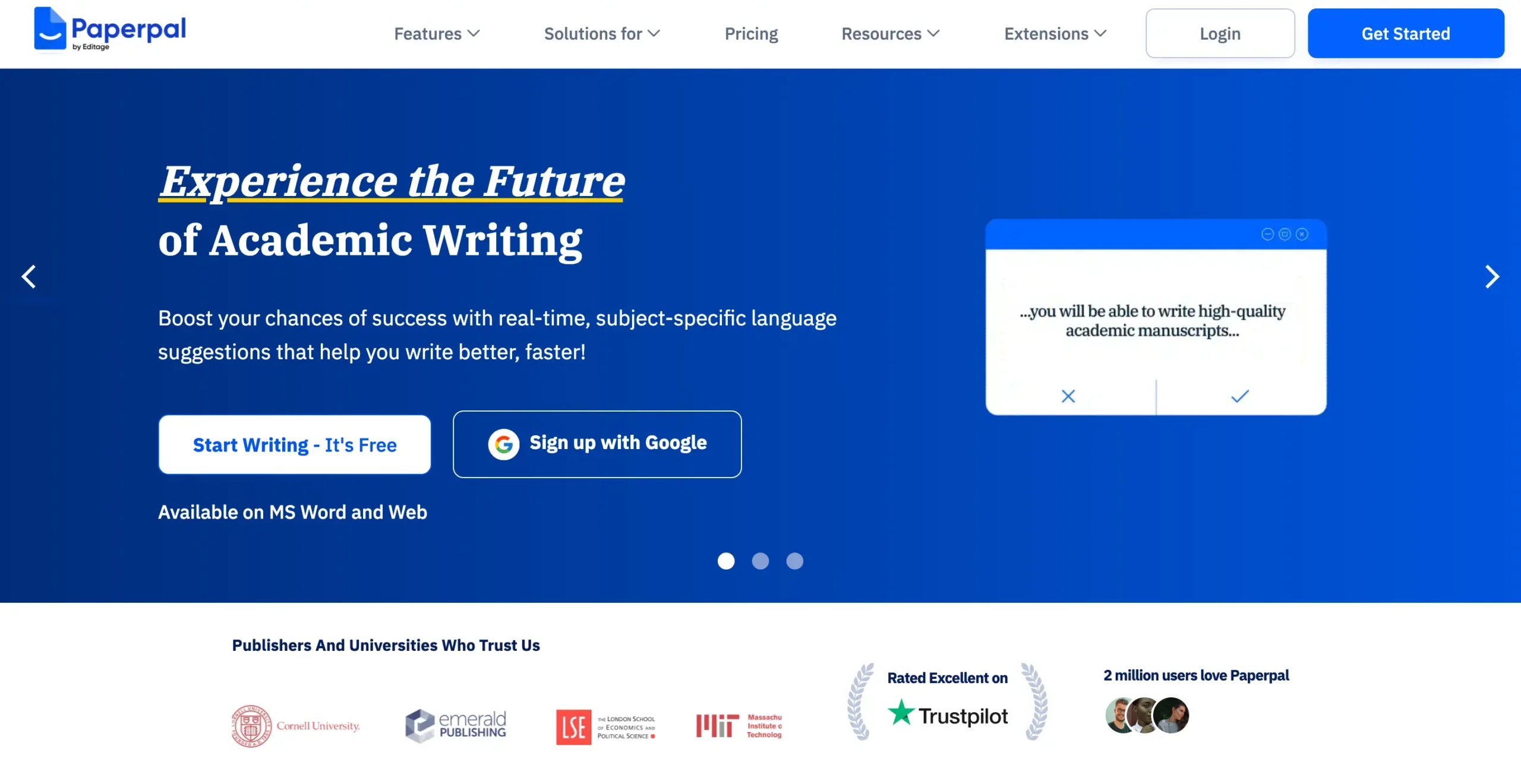
What I like about Paperpal
What I don’t like about Paperpal
Paperpal is an AI writing assistant that turns academic writing into something less painful.
Over 2 million academics use it.
Unlike ChatGPT or Grammarly, Paperpal is trained specifically on millions of published scholarly articles and backed by 22+ years of academic publishing experience.
This matters more than you might think. Generic AI tools don’t understand that “administered” works better than “added” when you’re writing about chemotherapy protocols.
Paperpal gets you science-backed answers from 250M+ research articles and lets you cite them in 10,000+ styles.
It supports over 30 languages for translation, so you can write in your native language and get accurate academic English.
Here’s what’s useful:
Unlike Jenni AI, which only works on the web, you can use Paperpal everywhere you actually write—web, MS Word, Google Docs, and Overleaf.
The free plan scans up to 7,000 words monthly for plagiarism—about 25 pages. It checks against 99 billion web pages, which is more thorough than most university systems.
What you won’t get is the focused writing experience that Jenni offers.
Paperpal tries to be a complete academic toolkit. It does grammar checking, plagiarism detection, 30+ submission compliance checks, and literature discovery.
This comprehensive approach has trade-offs—you get more features, but the writing assistance isn’t as streamlined.
If you need a tool that handles everything from research to submission, Paperpal makes sense. If you just want help writing, Jenni’s focused approach might work better.
Further reading: Read my complete Paperpal review.
Jenni AI wins on simplicity
Now that you know what Jenni AI and Paperpal are, what they aren’t, and what each of them does, let’s look at their interfaces and how easy they are to use.
Jenni AI offers a cleaner user experience than Paperpal. There’s a clear reason: it has fewer features. Fewer features mean less visual complexity.
This is Jenni’s main dashboard once you sign up and log in:
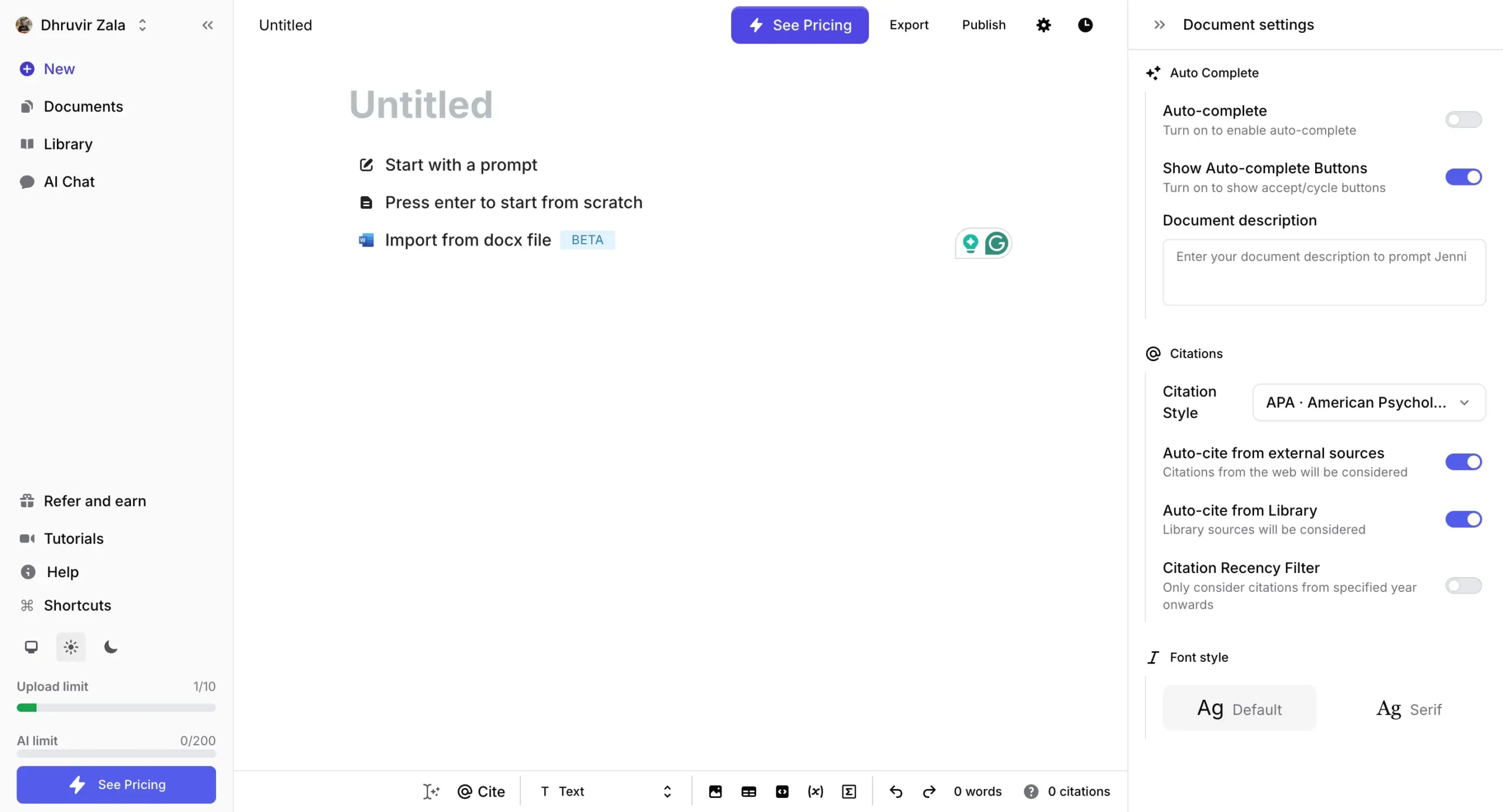
The left sidebar collapses, making the interface even simpler.
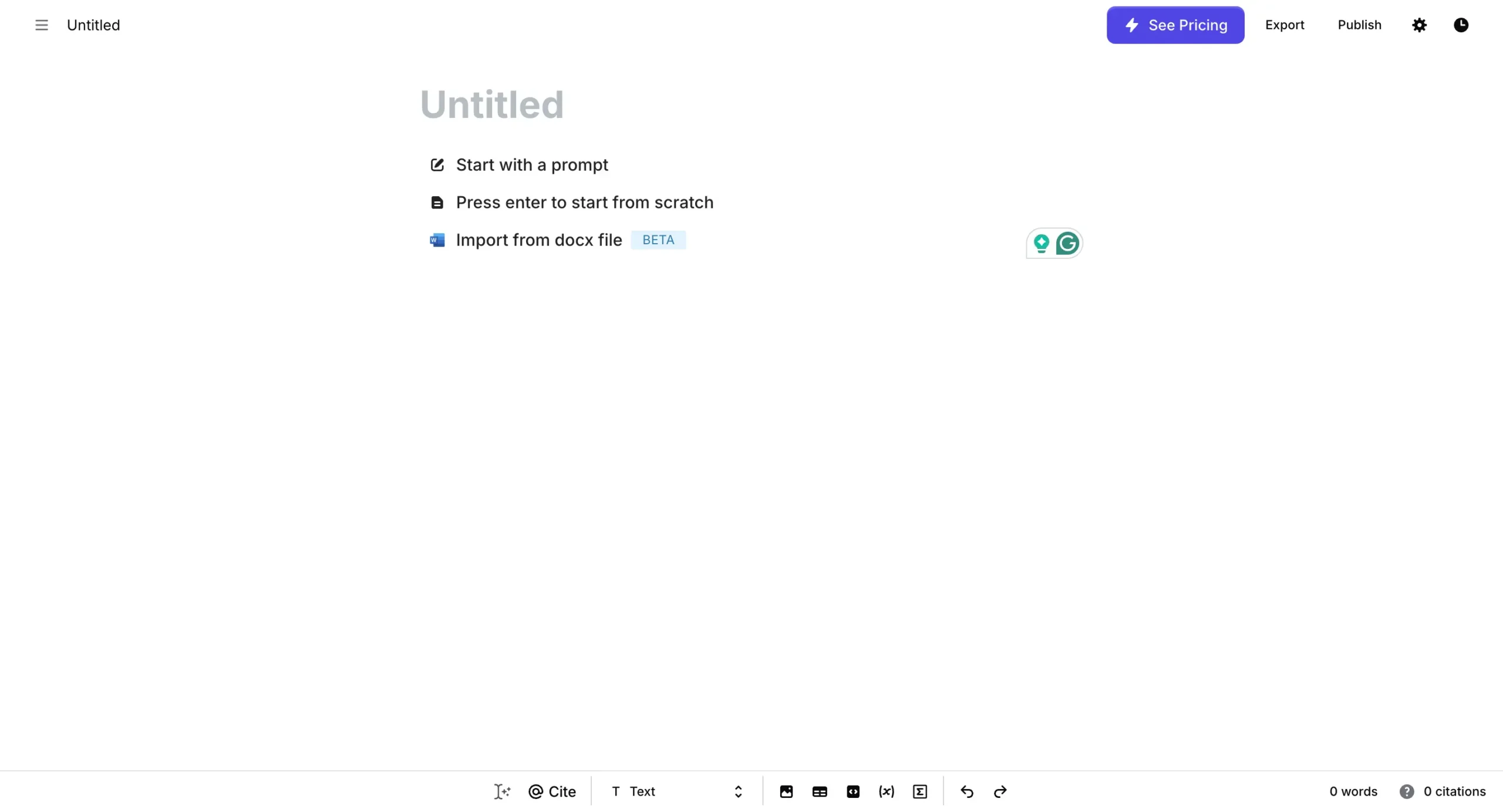
The left sidebar has everything you need: account settings, usage stats, buttons to create new documents, your content library, a button to open AI chat, and more.
The middle section is where you write.
You can see a menu strip at the bottom of the interface.

That’s where all your writing features live—you can even access them by pressing ‘/’ inside your writing area.
Enable or disable autocomplete, cite sources, add text blocks, insert tables, images, code, and more.
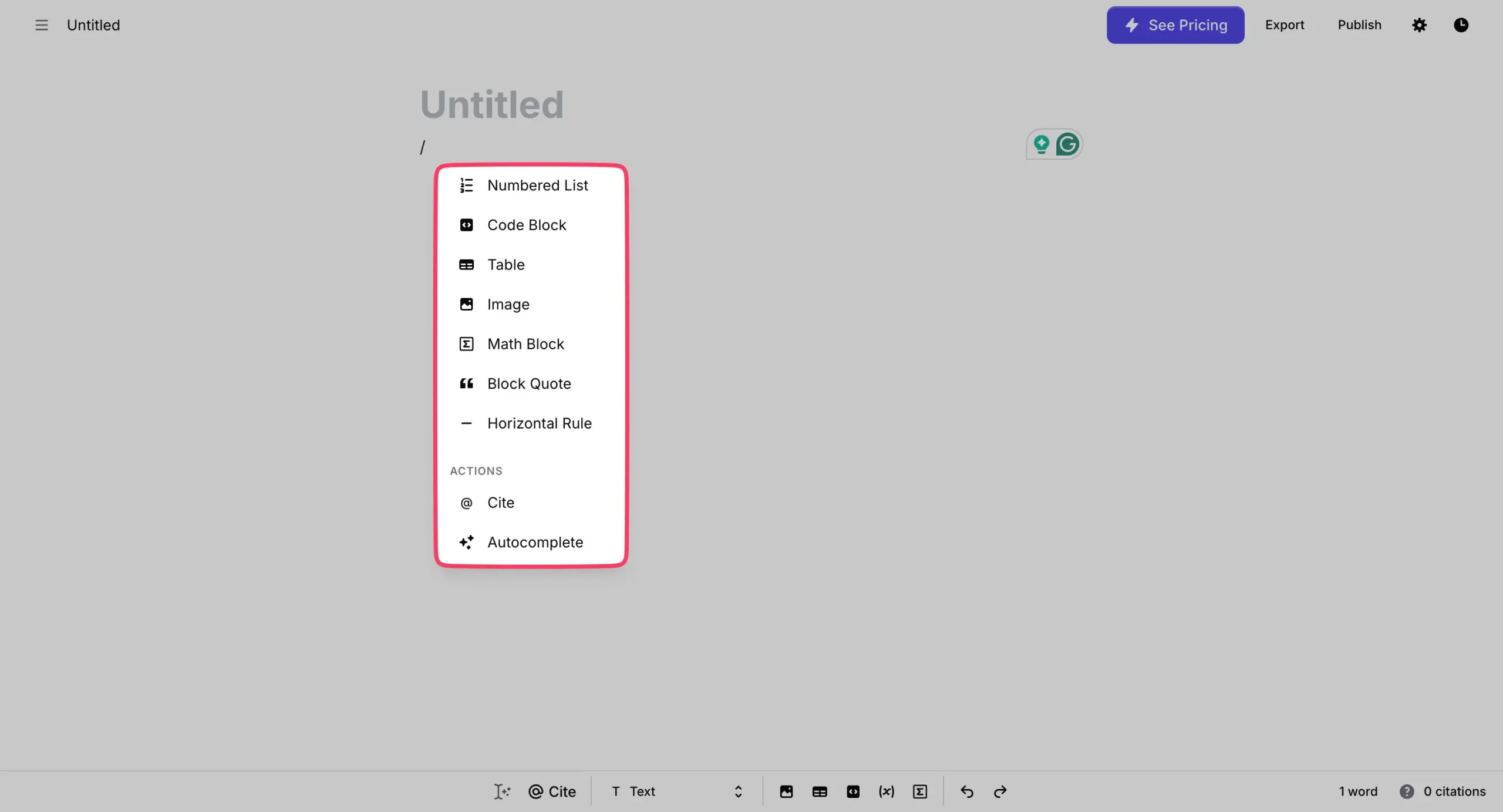
Export and publish options sit in the top right corner.
There’s also a document settings feature that opens as a right sidebar (more on that later).
At the far top right, you’ll see a clock icon. That’s your version control.
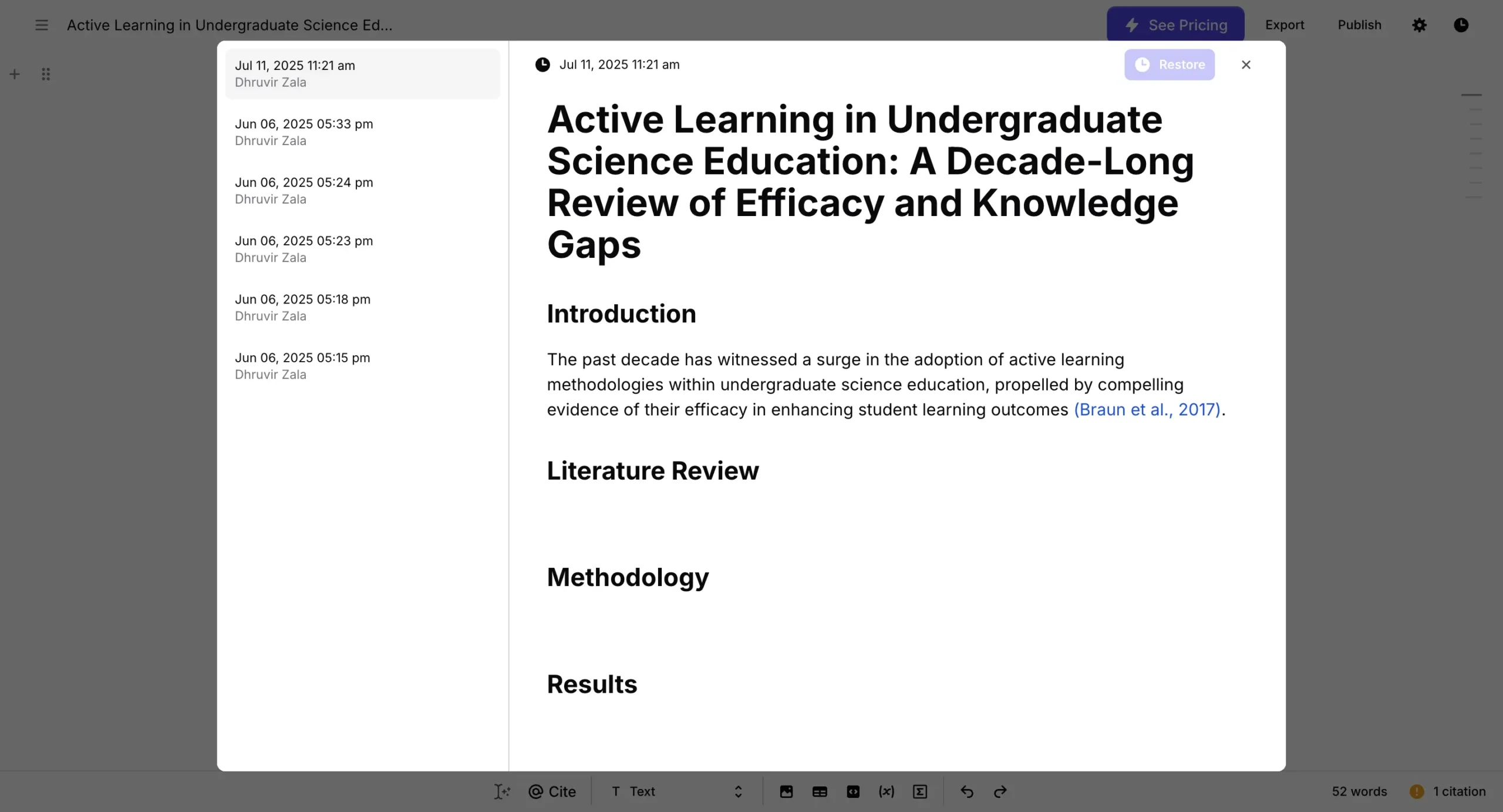
You can restore earlier versions if you mess something up.
Jenni AI’s interface is cleaner than Paperpal’s. The learning curve is minimal. Features are limited, so you can jump straight into the most important part without feeling overwhelmed: writing.
This is Paperpal’s main interface once you create an account:

They’ve kept it clean despite packing in many features, making Paperpal a complete package—an all-in-one tool for academics.
You get the same collapsible left sidebar and a whitespace-heavy interface.
But this is Paperpal’s home screen, where all your documents live.
Let’s look at the actual writing interface, where you’ll spend most of your time.

You have the same collapsible left sidebar, the middle panel for writing, and the right sidebar where all Paperpal’s features live.
Everything is in this single interface.
But thanks to the clean, whitespace-heavy design, you get used to it faster than you might think.
The best part?
All the features in the right sidebar can be accessed by pressing ‘/’ in your writing panel.
Both Paperpal and Jenni AI offer clean interfaces with minimal learning curves.
But based on the number of features alone, Jenni AI wins because it only does one thing: it helps you keep writing when you get stuck.
Paperpal destroys Jenni AI on academic research
Jenni AI doesn’t help you find research papers or do literature reviews. It just doesn’t.
What it does have is decent AI-powered citation discovery. Paperpal has this too. More on that later.
Paperpal is different. It actually helps with research.
Their “Research | Cite” feature runs on 250+ million scholarly publications. Their sister company, R Discovery, powers it.
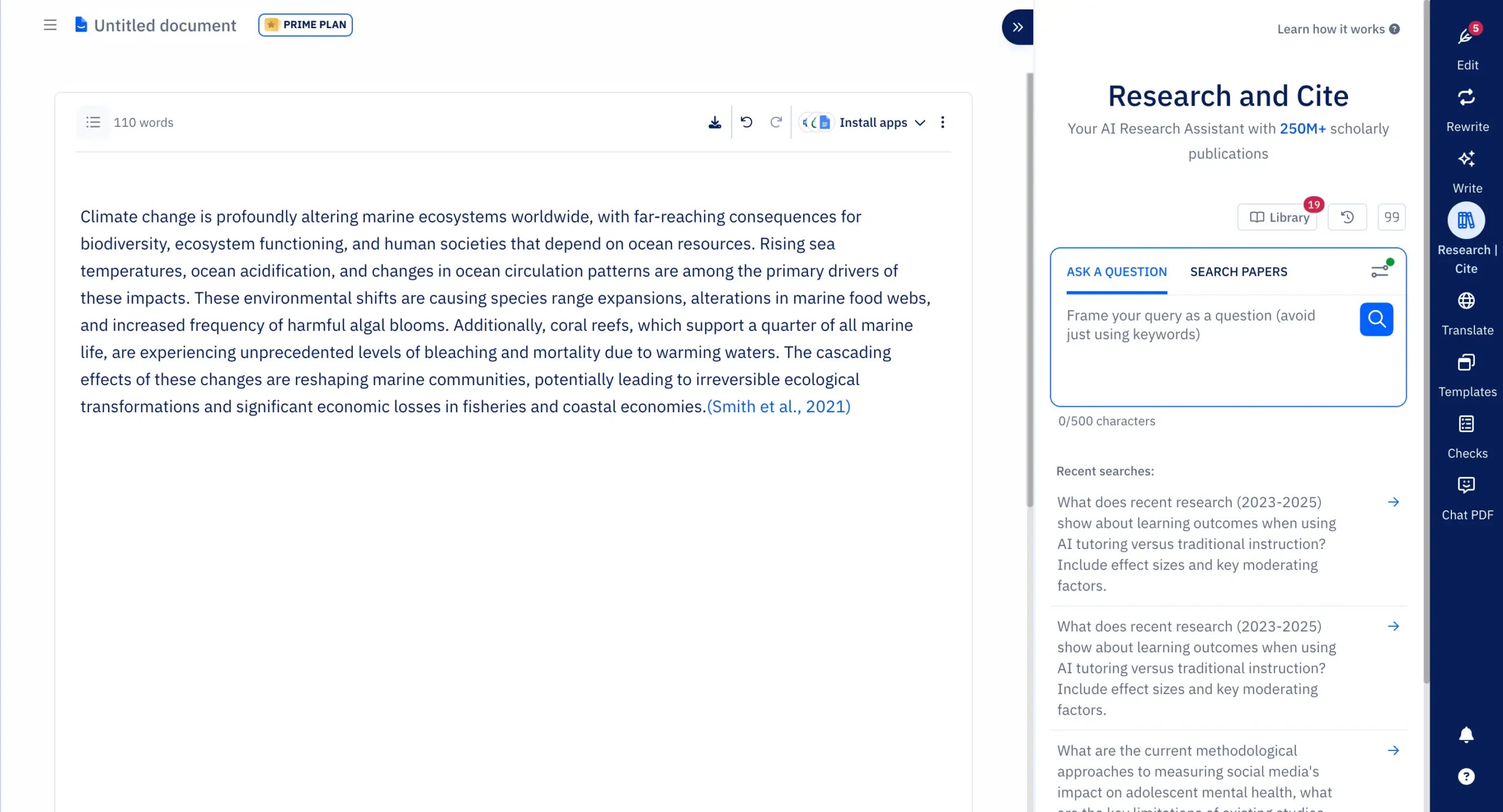
You get two main tools:
1. ASK A QUESTION: Ask any academic question. Get a thorough answer with citations and references. Think literature review, but faster.
2. SEARCH PAPERS: Find academic papers by keywords, DOI, or title. Simple inputs, relevant results.
Here’s what makes this powerful: these features live inside your writing interface. No switching between tools. Everything connects.
Example: I want to know what research says about “The effects of last night’s sleep on next day’s cognitive performance.”
I asked Paperpal that question.
Pro tip: phrase your query as a clear question, not a statement. Better results.
Within seconds, I get a detailed response with sources. I can drop any of it into my document with one click.
Important: Don’t trust AI output blindly. Always fact-check, especially for academic work. One bad citation can kill your paper.
Before asking questions, you can filter results by setting preferences.
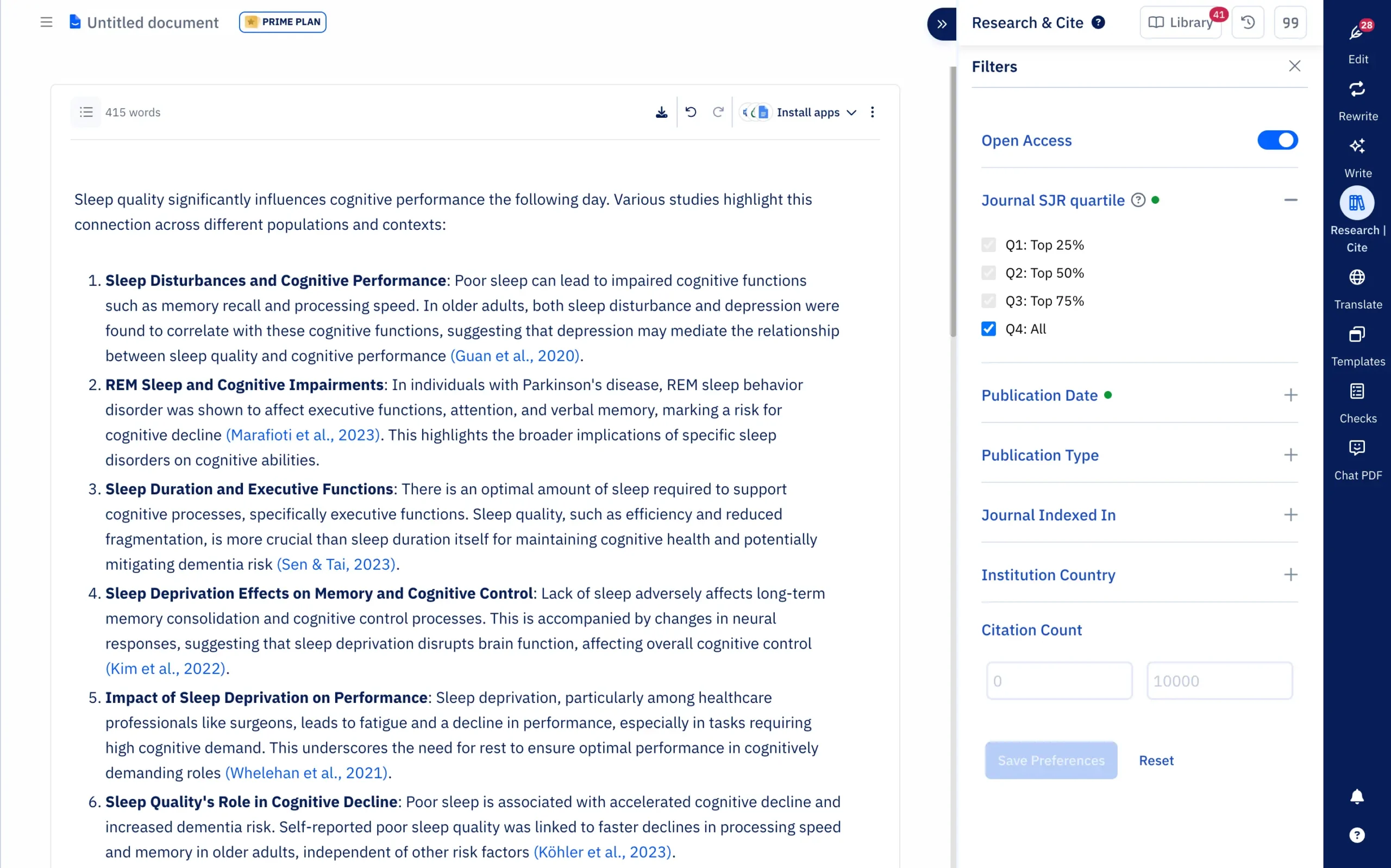
The paper search works similarly.
Click any paper to read the abstract inside Paperpal. Want the full paper? Click “read more.” You can also save papers to Paperpal’s library.
Bottom line: Paperpal destroys Jenni AI on research features. It’s not even close.
Further reading: If you need more research options, here are the 7 best AI tools for literature review that can save you months of work.
Both excel at academic writing, but differently
Both Jenni AI and Paperpal help with academic writing. But they work differently.
Let’s start with Jenni AI.
Jenni AI’s writing interface is clean. Cleaner than most software, actually.
Jenni AI gives you three ways to start:
- Start with a prompt: Tell Jenni what you want it to generate. Pick your outline style (standard headings, smart headings, or none). Set your citation style and other preferences.
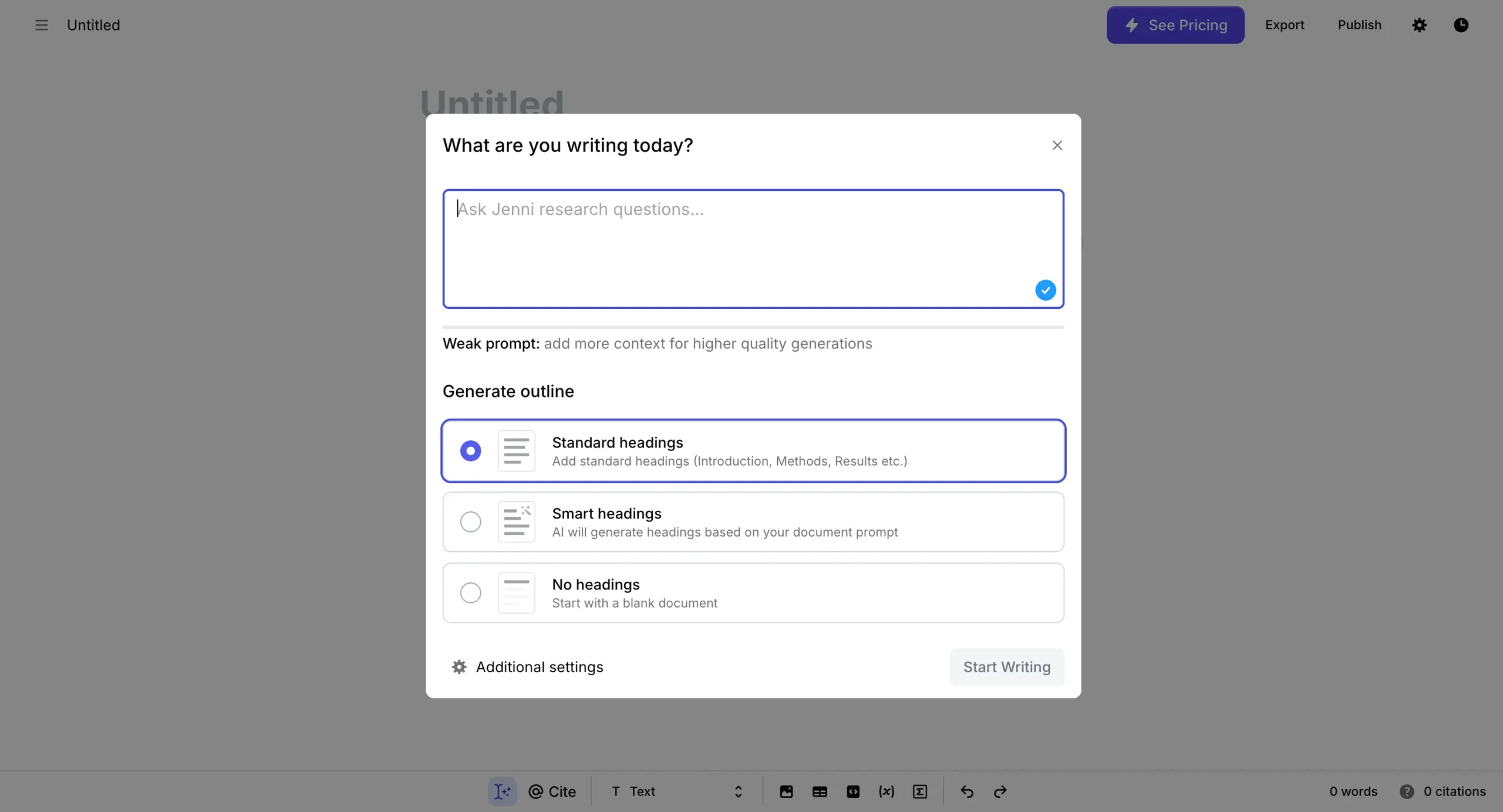
- Start from scratch: Open the empty writing panel, add a title, and hit Enter.

- Import a Word file: Upload your existing DOCX file. This feature is still in beta.
Let me try writing something real with Jenni AI.
I’ll use this prompt: “Do Facebook and Twitter make people dumber about politics?”
I picked smart headings and APA citation style.
In under 10 seconds, Jenni AI gave me a complete outline. Title included.
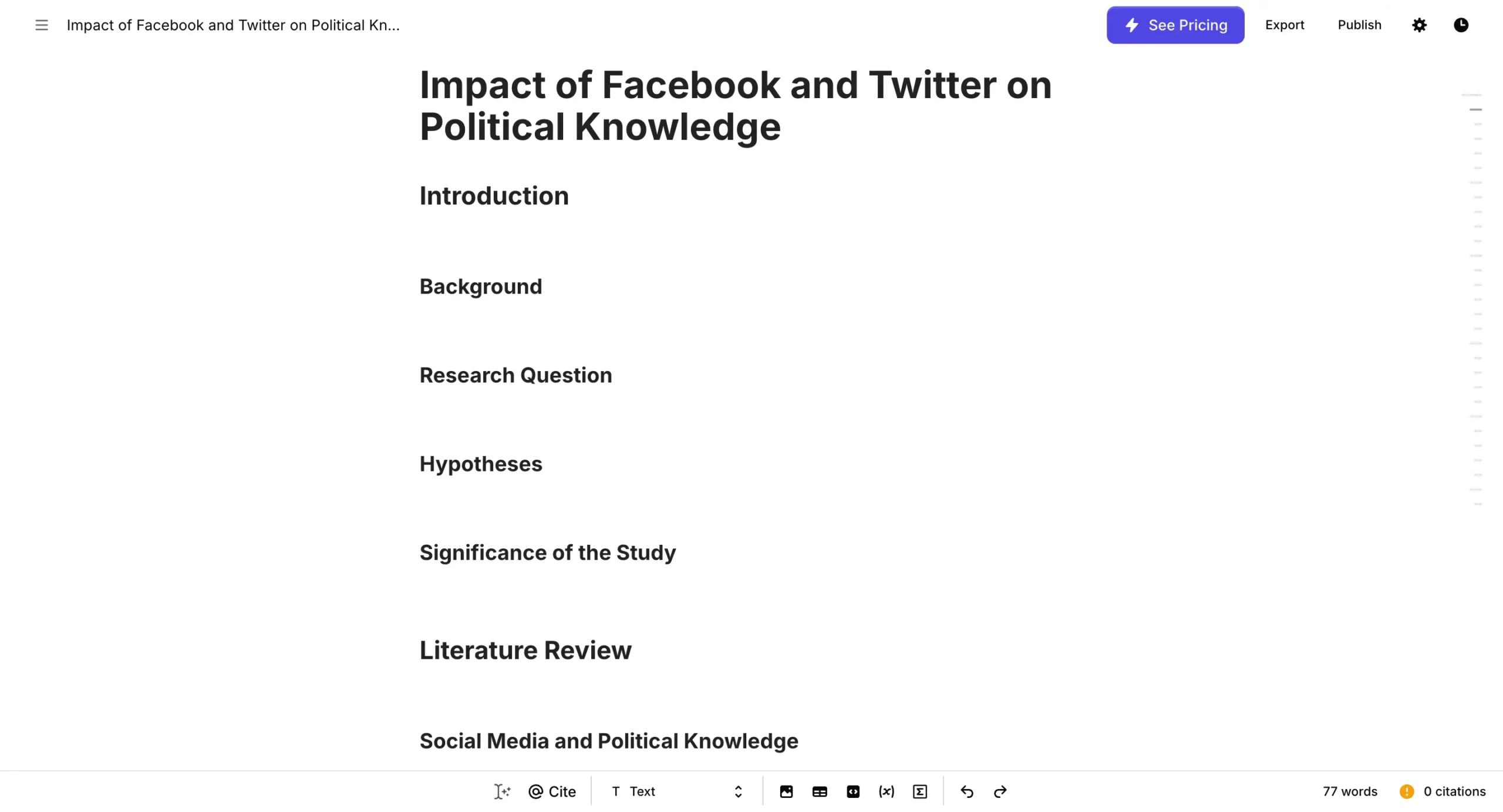
Here’s what I love: Jenni AI didn’t write everything for me. It just helped me get started. It didn’t do my thinking.
Now comes Jenni AI’s best feature—something Paperpal doesn’t have: AI autocomplete.
This is brilliant.
You can turn it on or off from the bottom menu.
Once you enable it, Jenni AI becomes a writing monster. A beautiful one.
Point your cursor under any heading. The autocomplete suggests content for that section.
You can keep doing this forever.
Warning: This feature can make you lazy. Everything Jenni suggests comes with citations, but some people stop thinking and just accept whatever it generates. Don’t do that. Always check the content and citations it adds.
Jenni AI also finds citations for you.
Press ‘@’ anywhere in the writing interface. Or click the ‘@ Cite’ button in the bottom menu.
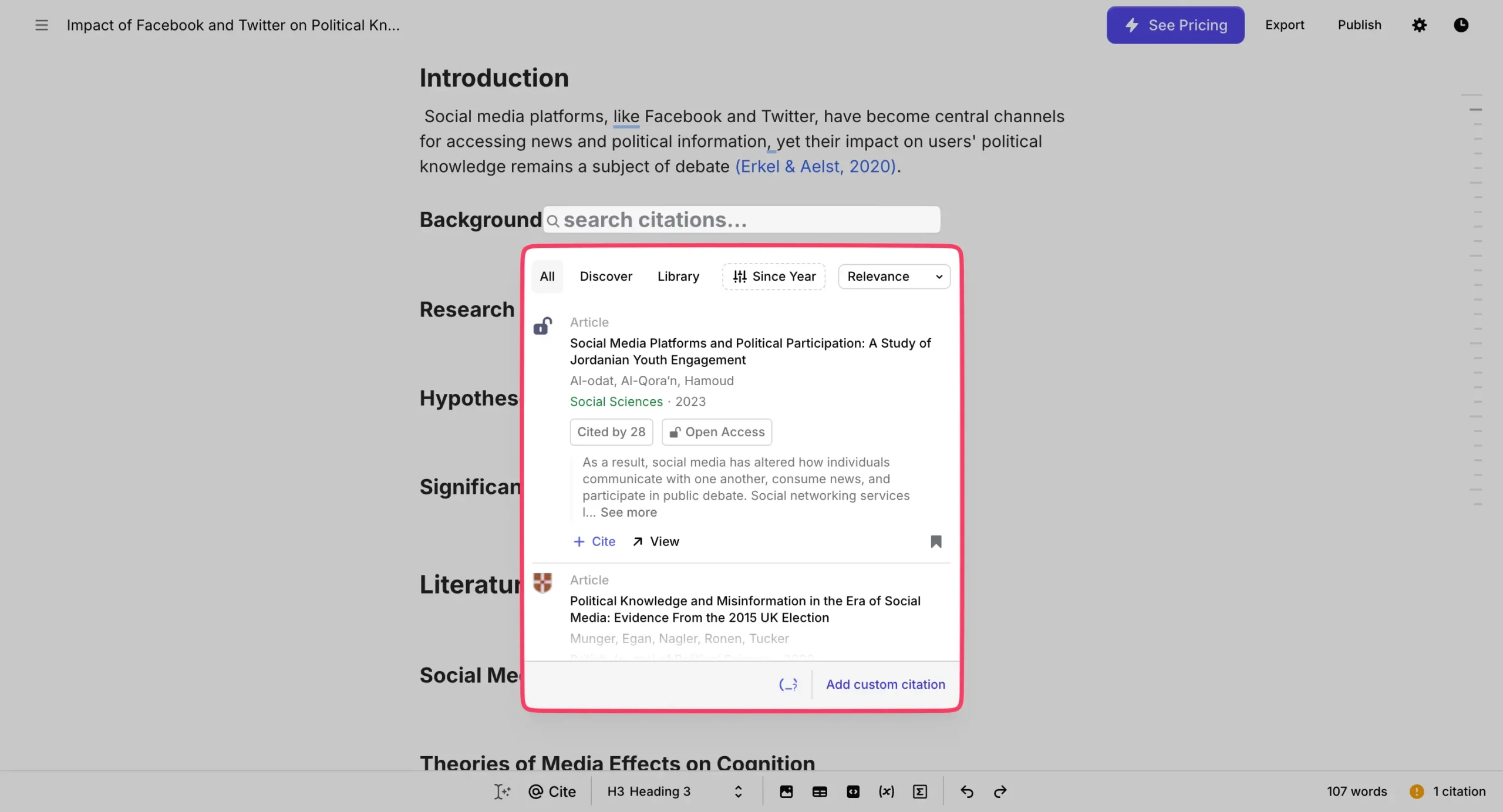
You can search for citations or add custom ones. Jenni even shows you the full paper, citation count, and whether it’s open access.
You can improve the text you’ve already written, too.
Select any paragraph and click “Chat” to open Jenni’s AI chat. Or use “AI Edit” to strengthen your writing, change tense, translate between languages, or adjust formality and technical precision.
I’m impressed with Jenni AI’s writing features. It helps when you’re stuck, not when you’re lazy.
Now let’s look at Paperpal.
Paperpal tries to be everything an academic writer needs. Grammar checking, AI features, translation, templates, submission checks—plus that “Research | Cite” feature I showed you earlier.
Paperpal has every writing feature Jenni AI has. Except one: AI autocomplete. That’s a shame, because autocomplete is useful and arguably Jenni AI’s best feature.
You can start writing in Paperpal in three ways:
- Start from scratch or upload a document
- Use Paperpal templates (Jenni AI doesn’t have templates)
- Use the ‘Write’ feature or ‘Research | Cite’ feature
Side note: Paperpal’s ‘Write’ feature is like Jenni’s AI chat, but without citations. You’ll need to fact-check everything it writes.
I tested the same question with Paperpal’s ‘Research | Cite’ feature: “Do Facebook and Twitter make people dumber about politics?”
In seconds, I got 318 words backed by six references.
But what if you want something specific, like just a paper title?
That’s where Paperpal’s templates shine.
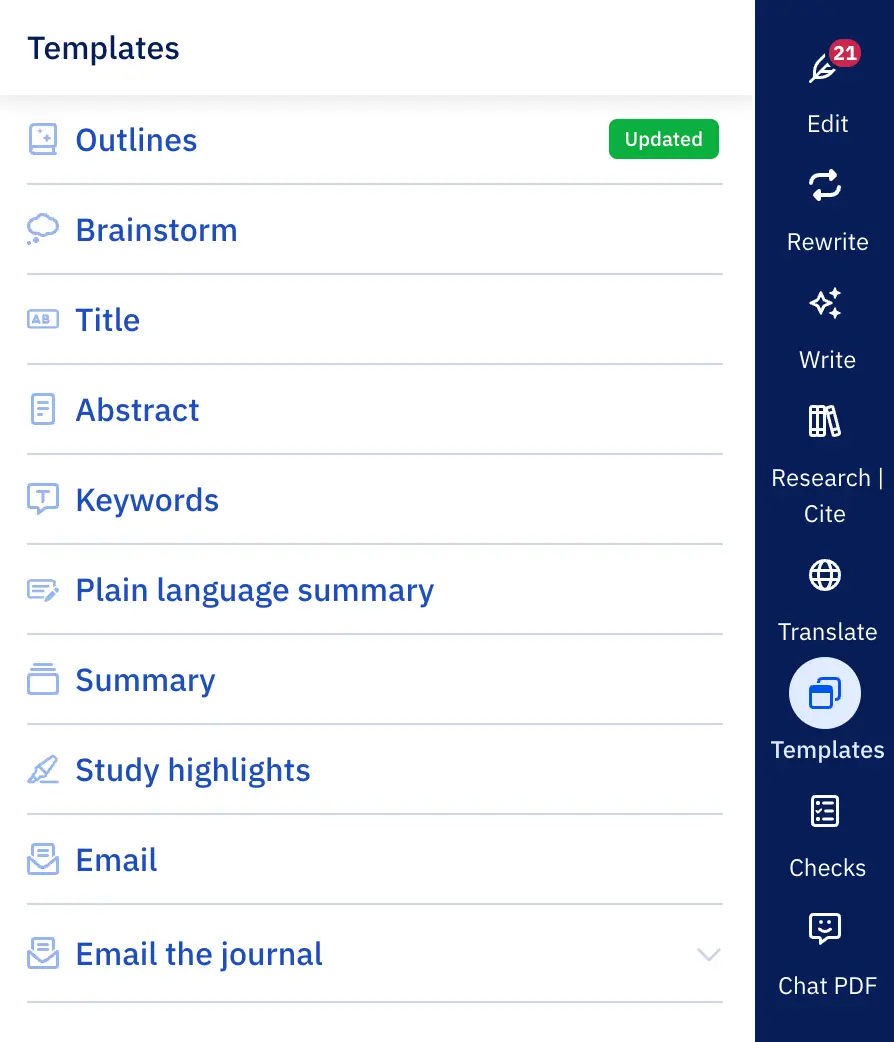
Paperpal has templates for everything: research articles, essays, thesis chapters, abstracts, and academic emails. You name it.
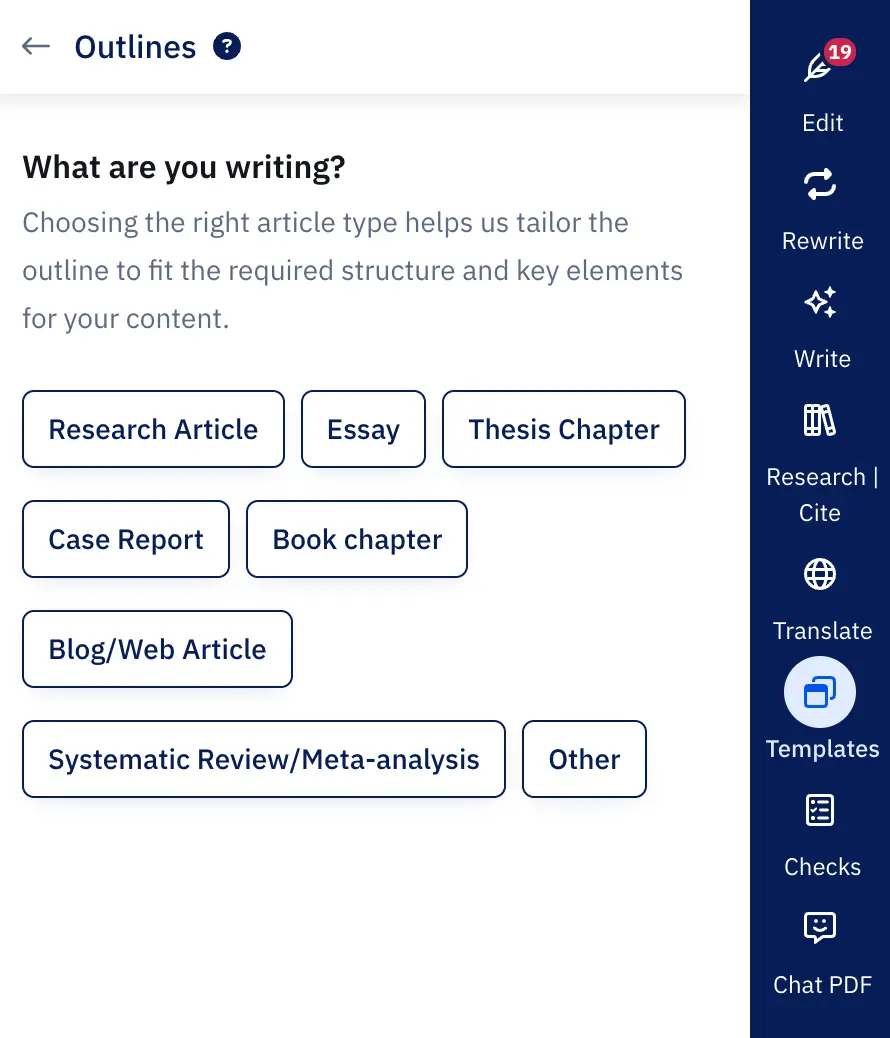
The templates save time.
Back to the writing interface with our 318-word output from Paperpal.
Here’s the cool part: Select any paragraph to use Paperpal AI on it. Just like Jenni AI.
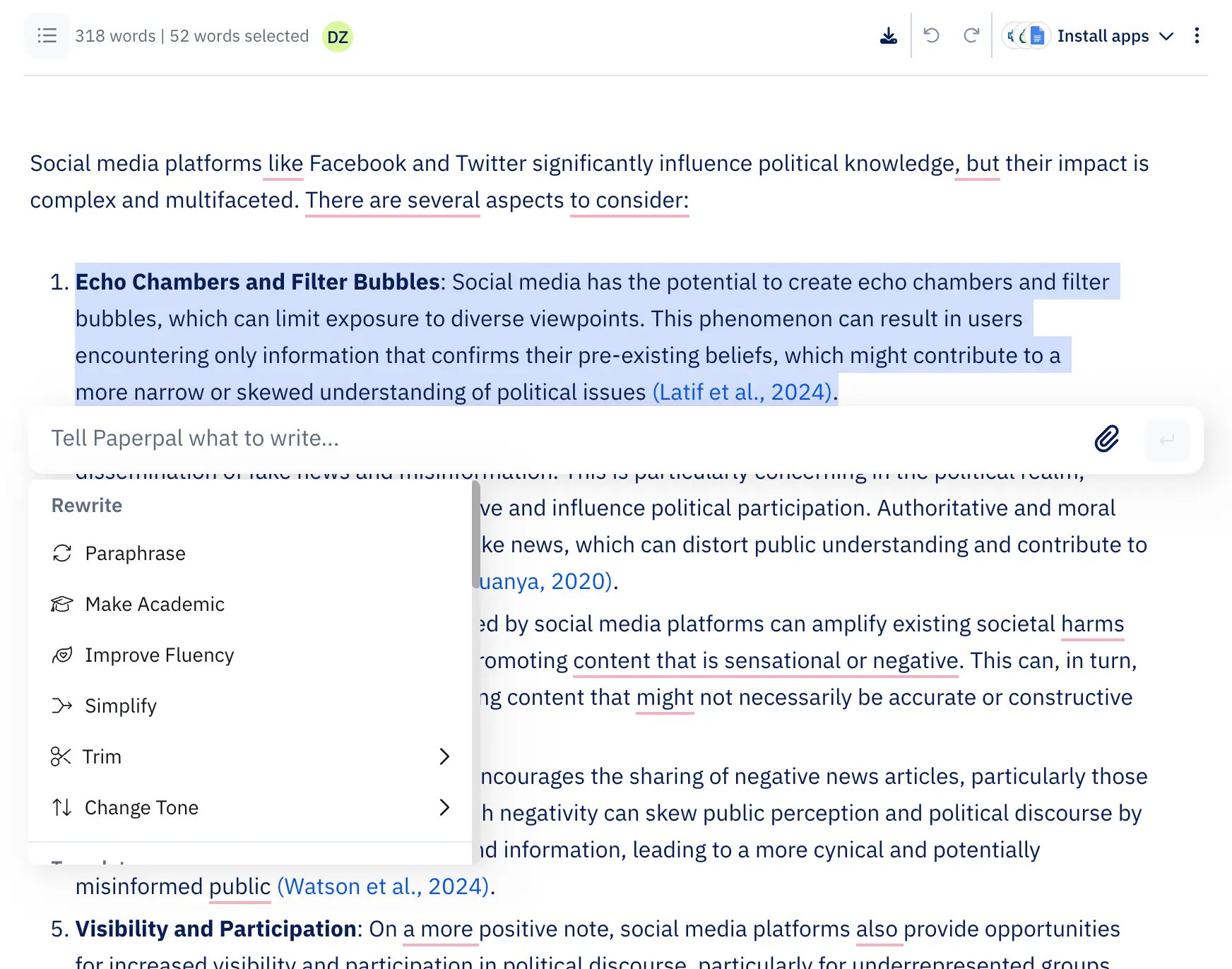
Even better: Select any paragraph that needs citations and click “@ Cite.” Paperpal searches millions of papers and suggests the most relevant citations for that specific paragraph.
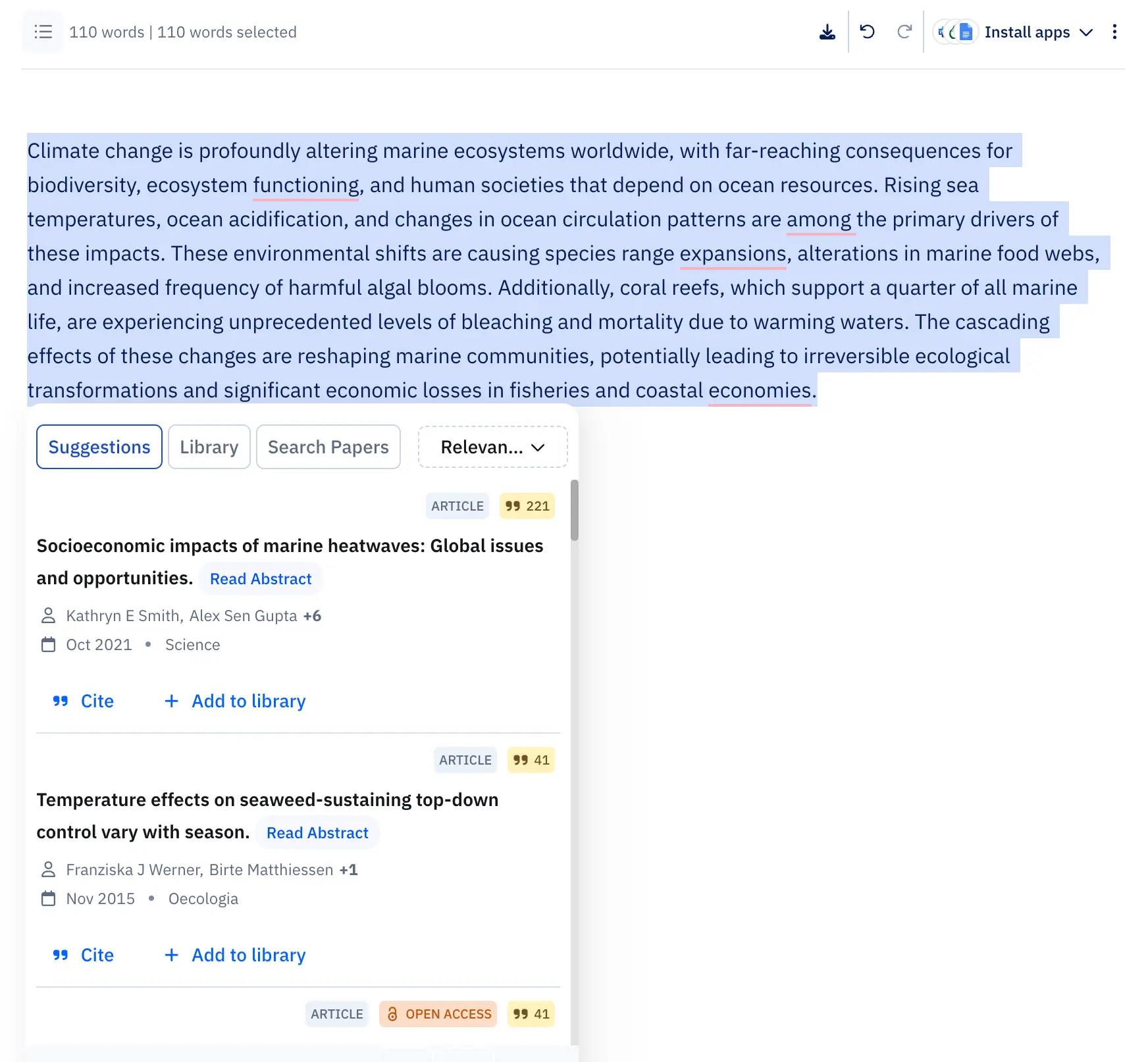
You still need to check if the citations actually fit. But this beats Jenni AI’s citation discovery, where you manually search and then dig deeper anyway.
Both tools offer powerful AI writing features.
Jenni AI’s unique strength is autocomplete. Paperpal’s are templates and automatic citation generation—plus seamless integration of research and writing.
Here’s something to consider: If you pick Jenni AI, you’ll probably need another tool for research. If you pick Paperpal, you’ll miss autocomplete but won’t need a second subscription.
You have to choose your path.
The good news? There’s no wrong choice here.
Paperpal does PDFs right
Both Jenni AI and Paperpal let you upload PDFs and chat with them using AI.
But Paperpal is much better at this. Here’s why.
Jenni AI’s approach is simple. Upload your PDF, and it appears in your Library. Open it, and you get the PDF on the left with an AI chat box on the right.
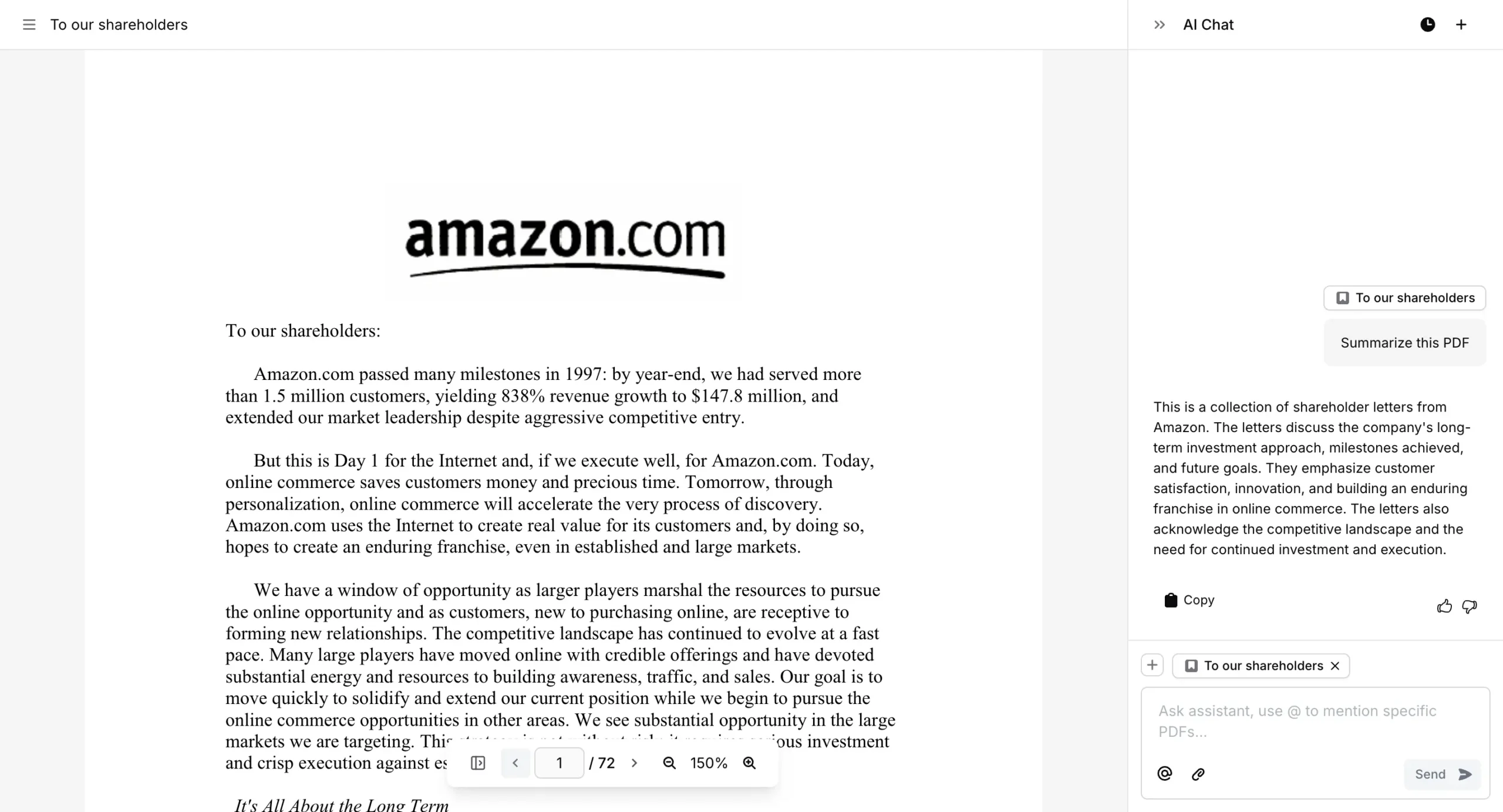
That’s it.
You can ask questions about the PDF, and it gives decent answers. But here’s the problem: ChatGPT, Claude, or Gemini can do the same thing. What makes this special?
Academic PDF tools should do more than just chat. You need note-taking, highlighting, annotations, real-time collaboration, the ability to highlight specific paragraphs and run AI on them. Jenni AI doesn’t do any of this.
There’s also a size limit: 15 MB maximum, 150 pages total.
The AI chat is useful, especially since they added “Library Context” and “Web Search” features.
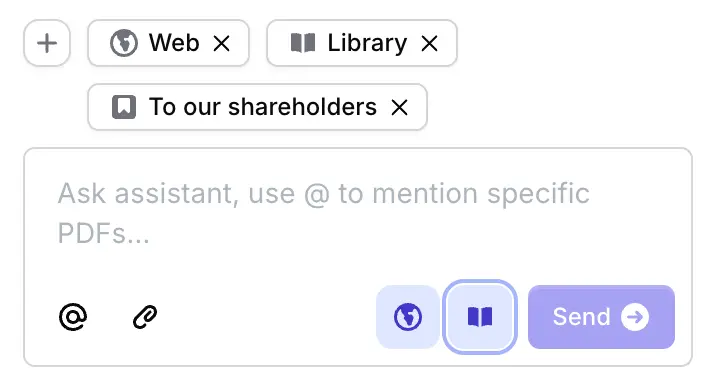
Paperpal works differently.
You can upload PDFs up to 25 MB.

Like Jenni AI, you see the PDF on the left and chat on the right.

But then things get interesting.
Above the PDF, you get three buttons:
- View PDF: Opens the PDF viewer
- Summary: AI-powered summary of the entire PDF, with metadata
- Related Papers: Shows papers related to your PDF, with titles, authors, journals, and publication dates
Jenni AI has none of this.
The automatic summary is brilliant. You understand the PDF’s content immediately when you open it.
The AI chat has two modes: Standard (free users, basic LLM) and Prime (paid users, advanced LLM).

Paperpal even suggests questions you can ask your PDF. These aren’t random—they’re useful for academics. Like “What are the main arguments made in the study?”
But here’s the best part: highlight any text in the PDF and ask Paperpal’s AI to summarize, explain, paraphrase, trim, or make it more academic.

Neither tool has built-in note-taking, sophisticated highlighting, or real-time collaboration. But Paperpal gets much closer to what you actually need.
Paperpal dominates grammar and plagiarism checking
Jenni AI does not offer grammar and plagiarism checking features.
Paperpal does.
The weird thing is this: unlike most tools that tend towards feature bloat by trying to be all-in-one tools, Paperpal is one of those rare tools that didn’t compromise on a single feature despite packing a lot of them.
But I digress.
Paperpal’s language, grammar, and consistency features work through their “Edit” tool. You write something, and suggestions appear instantly.
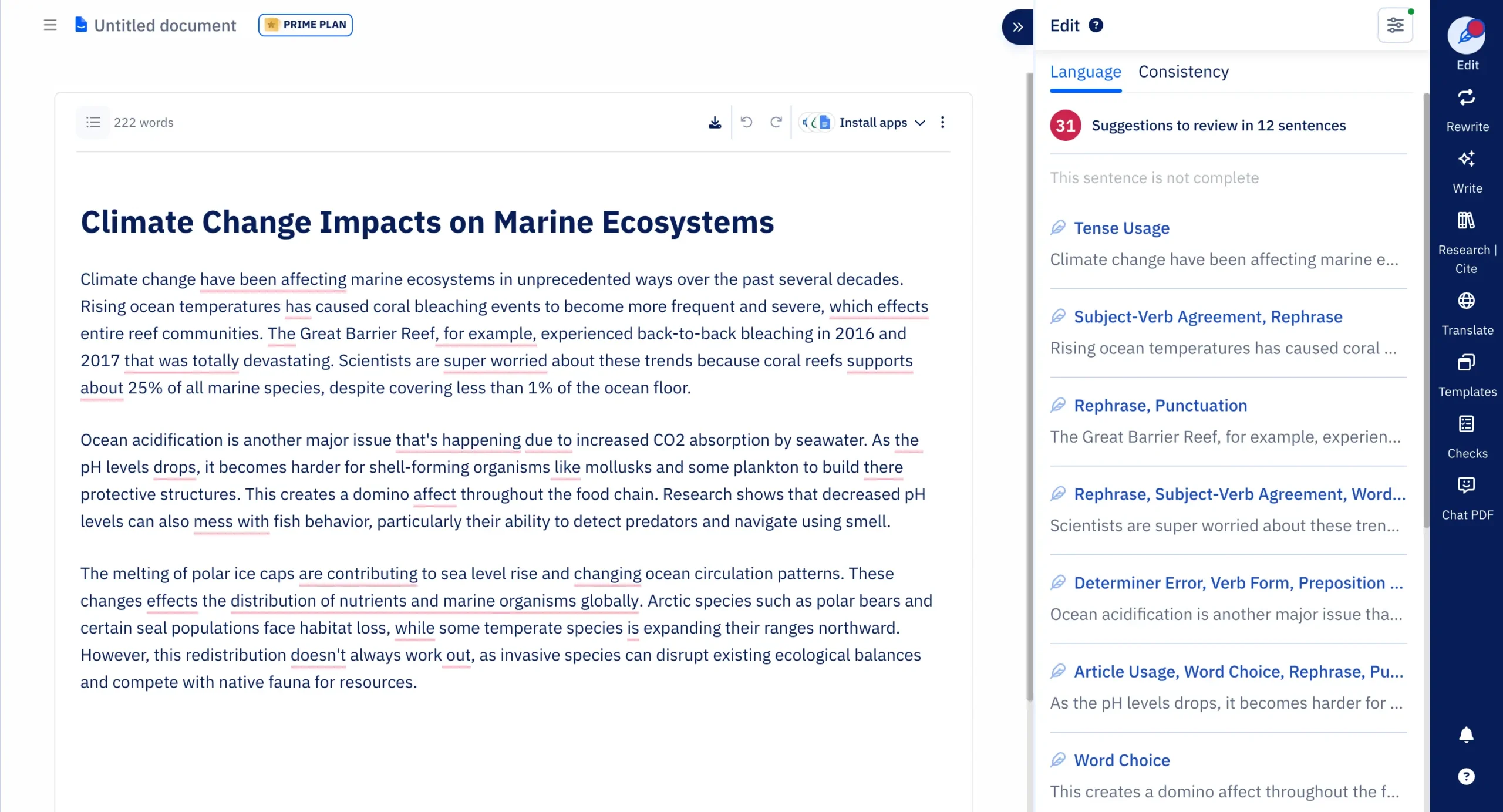
In another article, I tested Paperpal’s grammar checking feature against the same text I used for Grammarly.
Paperpal caught 31 grammar issues while Grammarly (which is often considered the king of grammar checking) just caught 17 errors for the same text. That’s impressive for an AI tool.
What makes this better than Grammarly?
Paperpal was trained on 250+ million research papers. It understands academic writing conventions. It knows when you should use passive voice in methodology sections. It catches mistakes that matter to journal editors.
Each suggestion shows you the problem type—tense usage, punctuation, phrasing—plus an explanation. Just like your writing tutor does.
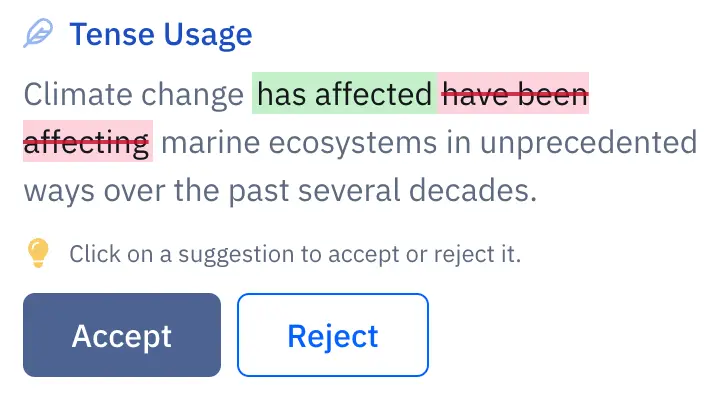
The consistency checker runs separately. It finds mismatched date formats, inconsistent terminology, and mixed US-UK spellings. Academic papers need this level of precision.
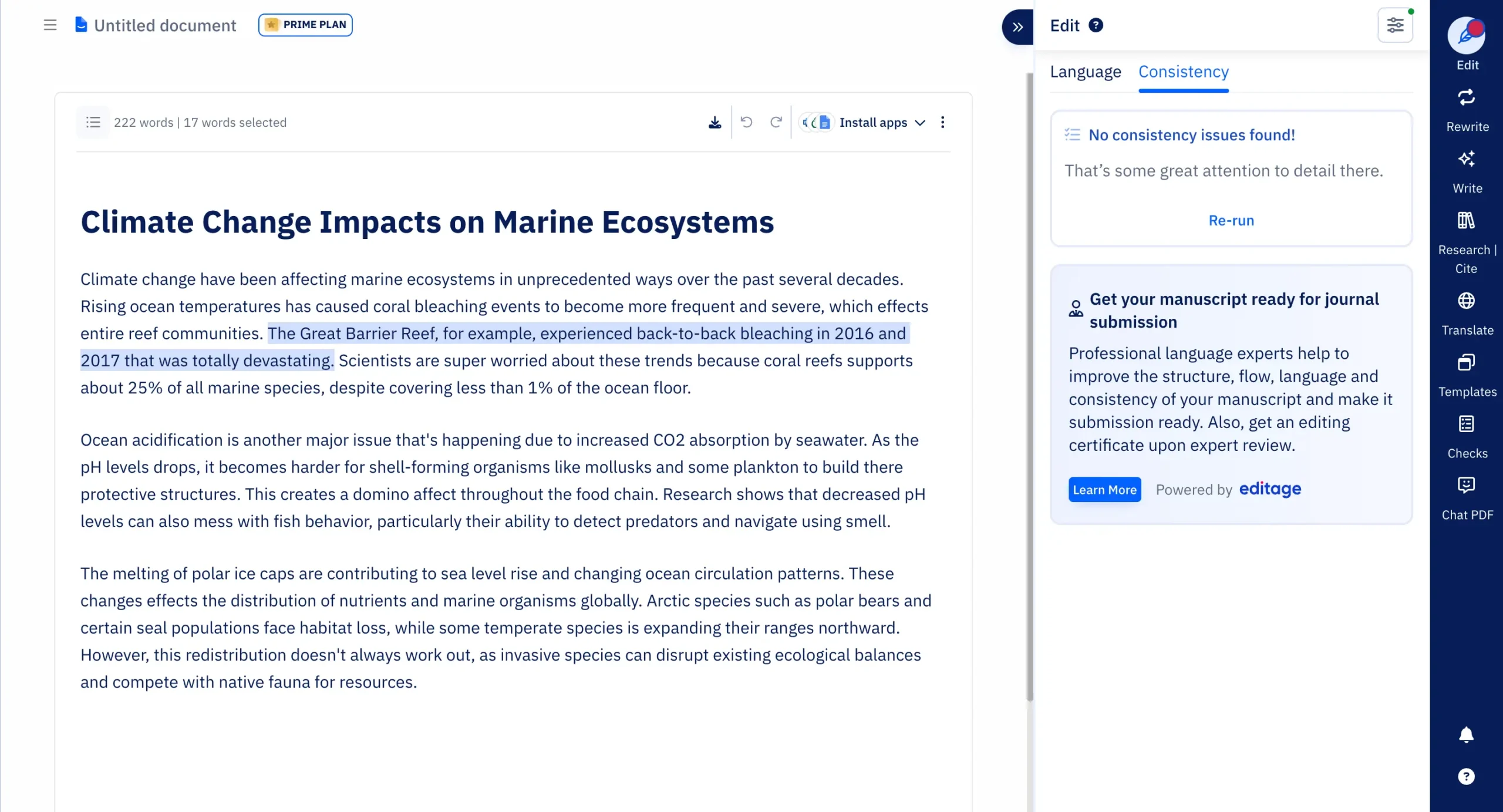
But here’s where Paperpal really shines: plagiarism detection.
The free plan scans 7,000 words monthly against 99 billion web pages plus 200 million research articles. The Prime plan bumps this to 10,000 words monthly with detailed reports.

This database is six times larger than what Grammarly checks. More importantly, it focuses on academic sources—research papers, dissertations, scholarly articles. Not random blog posts.
Upload your document. Wait a few minutes. Get a detailed report showing similarity scores and exact source matches.
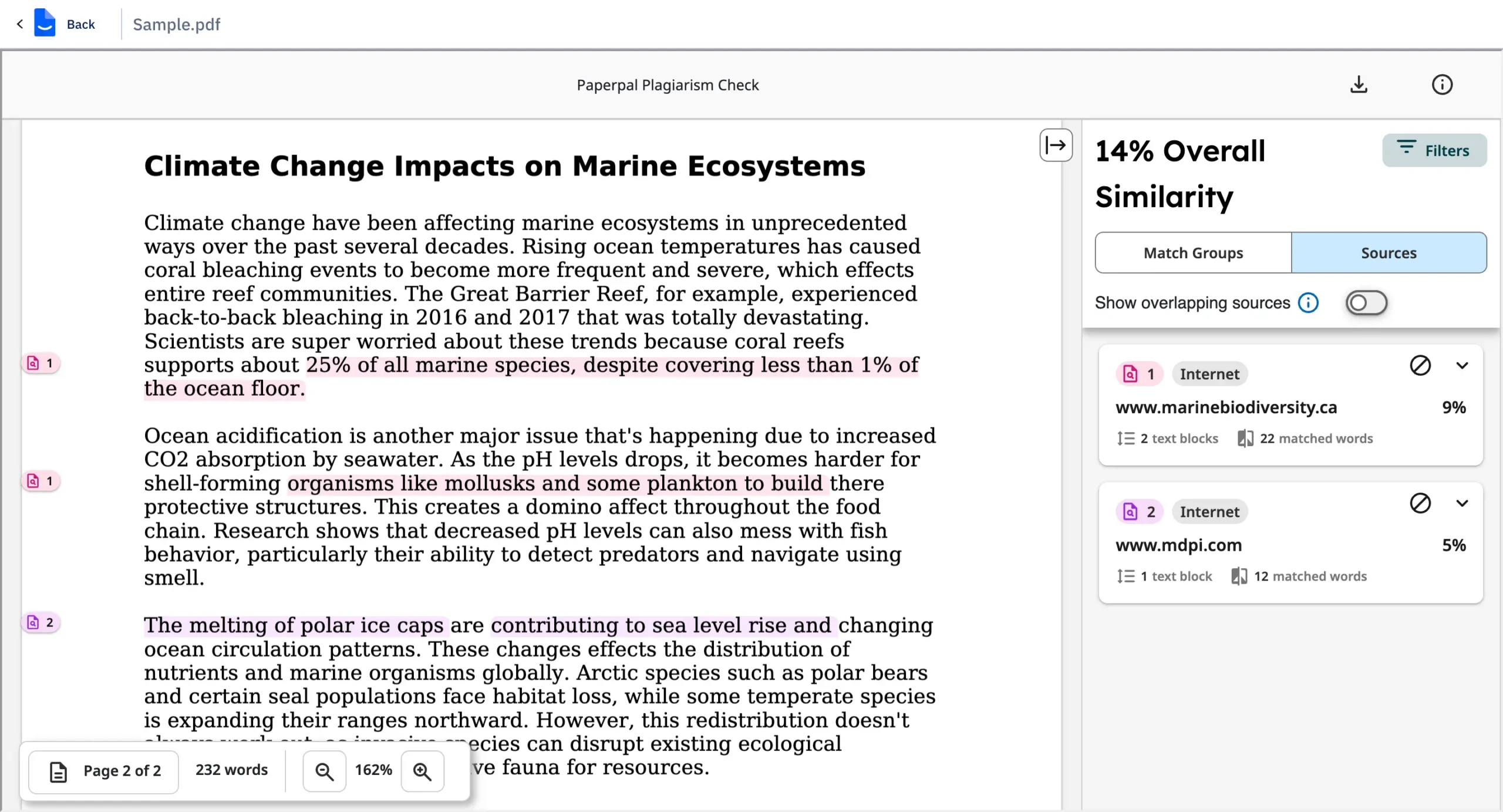
The real magic happens with Paperpal’s other checking features.
AI Review evaluates your entire manuscript for language quality, readability, and logical gaps. No other tool in my knowledge does this.
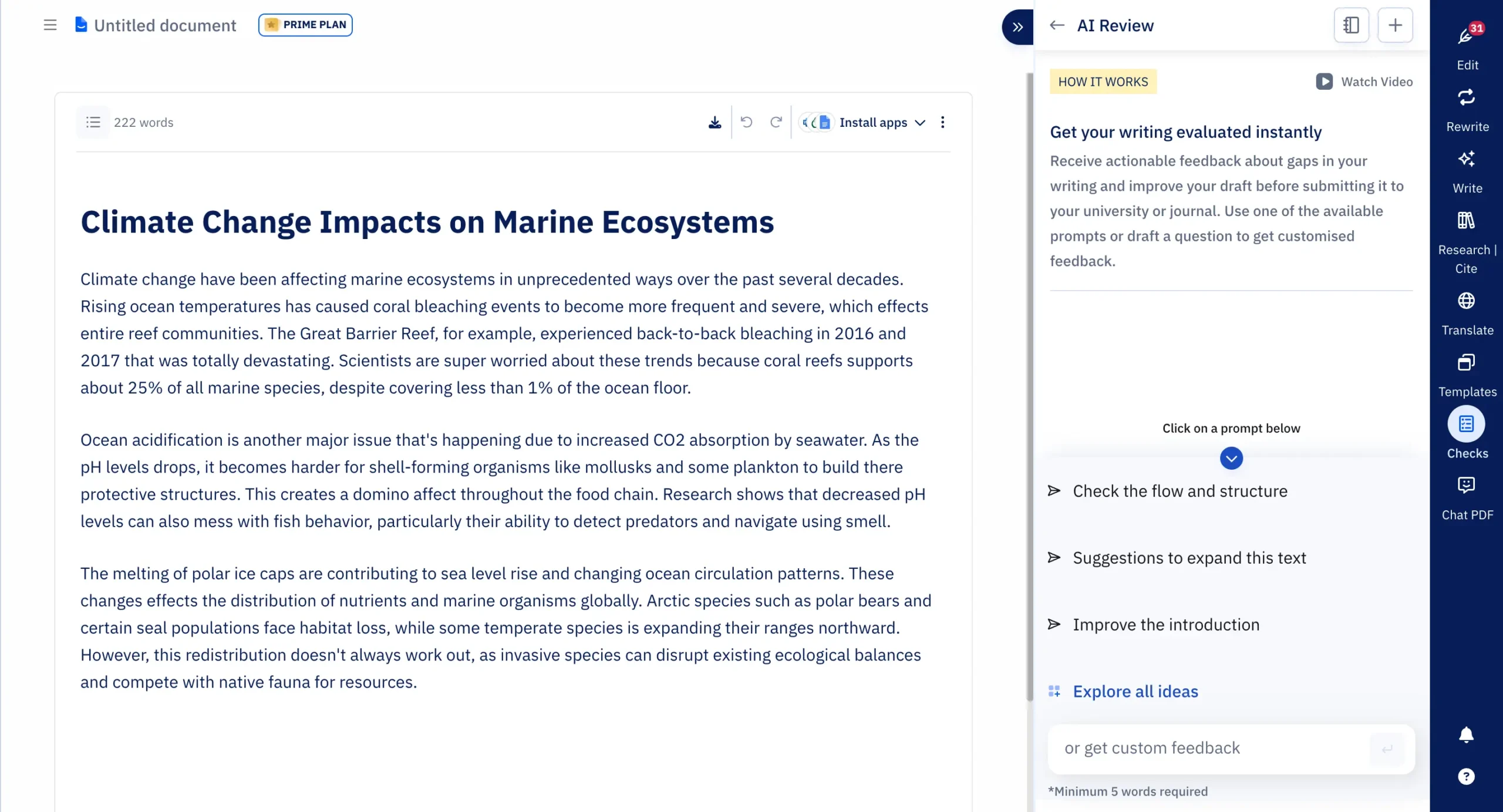
Journal Submission Check runs over 30 technical checks before you submit to publishers.

It catches formatting errors, citation problems, and manuscript issues that trigger desk rejections.

These features matter if you’ve ever received a rejection letter citing “language issues” or “formatting problems.”
Jenni AI offers none of this. Zero grammar checking. Zero plagiarism detection. Zero manuscript evaluation.
This isn’t necessarily bad. Jenni AI focuses on helping you write when you’re stuck. It does one thing really well.
But if you need your writing polished and checked before submission, you’ll need another tool anyway.
Paperpal handles everything in one place. You can write, edit, check grammar, scan for plagiarism, and prepare for submission without switching tools.
For anyone comparing Paperpal vs Grammarly specifically for academic work, Paperpal catches more issues and understands scholarly writing better.
Paperpal wins on integrations
The integration game is where things get interesting. And by interesting, I mean frustrating if you pick the wrong tool.
Jenni AI is a web-only experience. You open their website, write your paper, and export it when you’re done. That’s it.
They’re working on a Microsoft Word extension, but it’s still in waitlist mode. You can sign up to get notified when it launches, but right now it doesn’t exist.
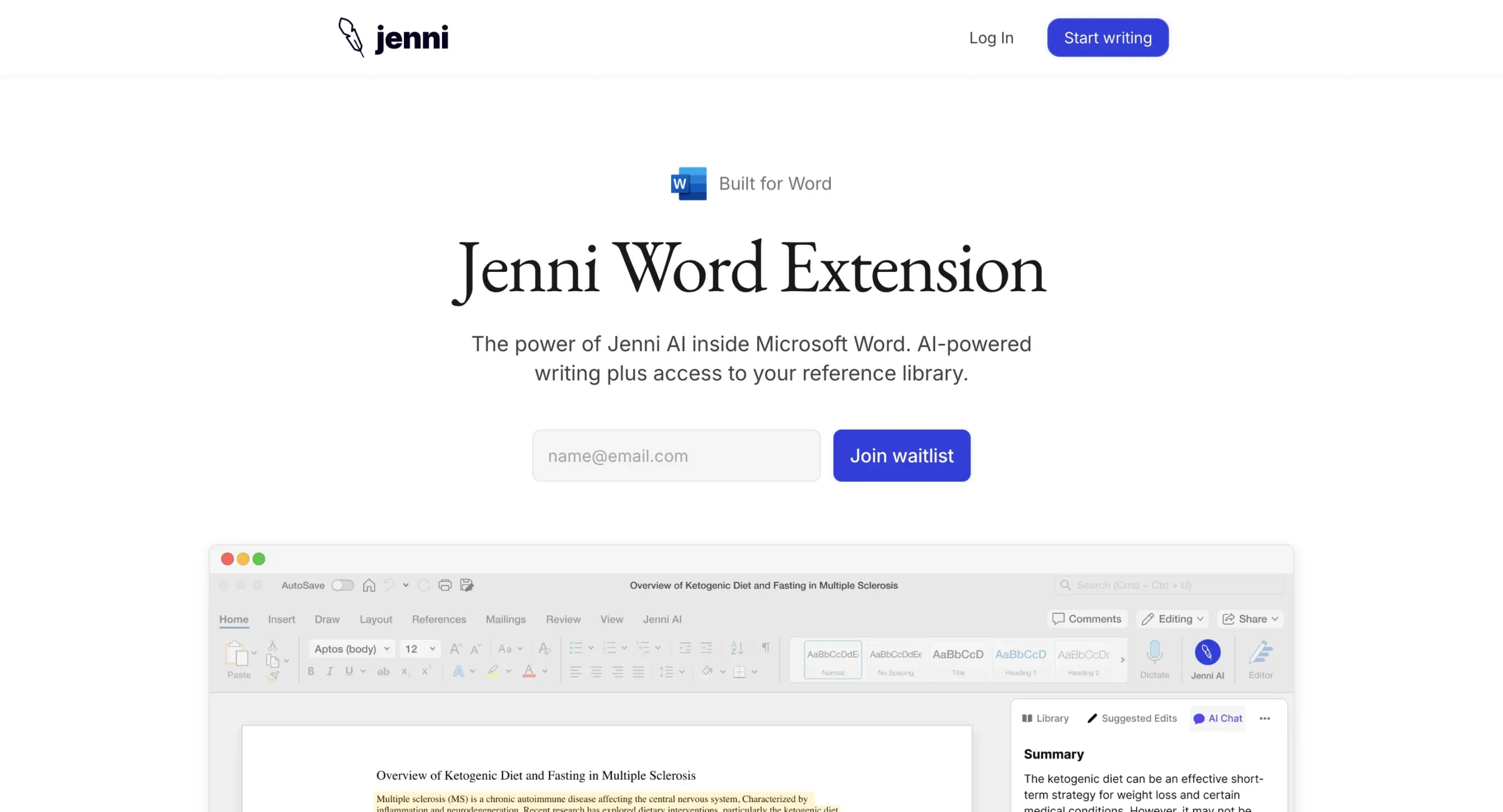
So for now, you’re stuck with their web interface. Write everything there, export when you’re done, and hope the formatting survives the journey to Word.
If you’re the type of person who likes to write everywhere—on your phone during commutes, in Google Docs for collaboration, or directly in LaTeX editors—Jenni AI won’t help you.
Paperpal takes a different approach. They want to be everywhere you write.
Here’s what they offer:
The best part?
Everything syncs. Your library, your documents, your settings—they follow you across platforms.
There’s also a practical consideration: team collaboration.
If you’re working with supervisors or co-authors who prefer Google Docs, Paperpal lets you share documents and get feedback without forcing everyone to learn a new tool.
Jenni AI?
You’d need to export your work, share it, collect feedback, and then somehow incorporate changes back into their web interface. That’s friction.
Paperpal costs less but gives you more
Both tools start free, but their paid plans tell different stories.
Jenni AI keeps it simple:
Free plan: You get 200 AI autocompletes per day, 10 PDF uploads, and basic features. That’s actually generous for testing.
Paid plan: $30/month or $12/month if you pay yearly. That’s it. One price, unlimited everything.
The yearly discount is solid—60% off. If you’re committed, it’s a no-brainer.
Paperpal offers more flexibility:
Free plan: 200 grammar suggestions monthly, 5 daily uses of writing features, and 7,000 words of plagiarism checking. Not bad.
Prime plan: $25/month, $18.30/month quarterly, or $11.60/month annually.
Wait, there’s more.
I negotiated an exclusive 30% discount for readers. Use code DZ30 at checkout through this link, and your first payment drops by 30%.
That brings the annual plan down to $97.30 total—about $8.10/month.
Pick your path
You have two good options. But you only need one.
Here’s how to decide:
Choose Jenni AI if:
Choose Paperpal if:
Most people should pick Paperpal. Here’s why:
You’ll eventually need grammar checking and plagiarism detection anyway. Buying separate tools costs more than Paperpal’s single subscription. Plus, you get research features and integrations that Jenni AI doesn’t offer.
The only exception?
If you already have Grammarly Premium and a research workflow you love, Jenni AI’s focused approach might appeal to you.
Both tools offer free trials. You can’t make a wrong choice here.
But based on features, integrations, and price, Paperpal wins for most academic writers. It does more, costs less, and works everywhere you write.
Further reading: The 5 Awesome AI Research Paper Writers To Write Exceptional Academic Papers
Disclosure: Our content is reader-supported. If you click on certain links we may make a commission.
Meet your guide
Dhruvir Zala
I help businesses and professionals stop wasting money on the wrong software. Most software reviews are just marketing in disguise. So I started writing the reviews I wish I had: thoroughly tested, brutally honest, and focused on what matters.
Best AI writing tool for academics?
Paperpal wins. More features, lower cost, works everywhere.
Get 30% off with code DZ30

Wait — You’re still writing papers the slow way?
Most academics waste hours fixing grammar, checking plagiarism, and hunting for citations. I did too. Then I tried Paperpal. It caught 31 grammar issues in text where Grammarly only found 17. Plus plagiarism detection, citation search, and research tools. All in one place.
Use code DZ30Code copied! to get 30% off your first payment — saves you about $35
